Energy Production Policy and Regulation in Australia - BACC305
VerifiedAdded on 2023/06/10
|8
|2763
|488
Essay
AI Summary
This essay provides a detailed analysis of energy production policy and regulation in Australia. It begins with an introduction highlighting the importance of environmental conservation and the role of energy in economic growth. The essay then delves into the current policy, focusing on the government's efforts to regulate the energy sector for reliable, affordable, and environmentally friendly production. It identifies deficiencies such as increasing energy costs, inefficient energy usage, pollution from energy production, and a lack of skills for a cleaner economy. The essay assesses the success of the government's policies in addressing these deficiencies, including price and energy utilization reforms, as well as air pollution reforms. The essay concludes with recommendations for improvement, such as educating the public on efficient energy use, promoting renewable energy sources, and investing in feed-in tariff schemes and renewable portfolio standards. The essay emphasizes the vital role of energy production in the national economy and the need for effective policies to regulate its production, distribution, and consumption.
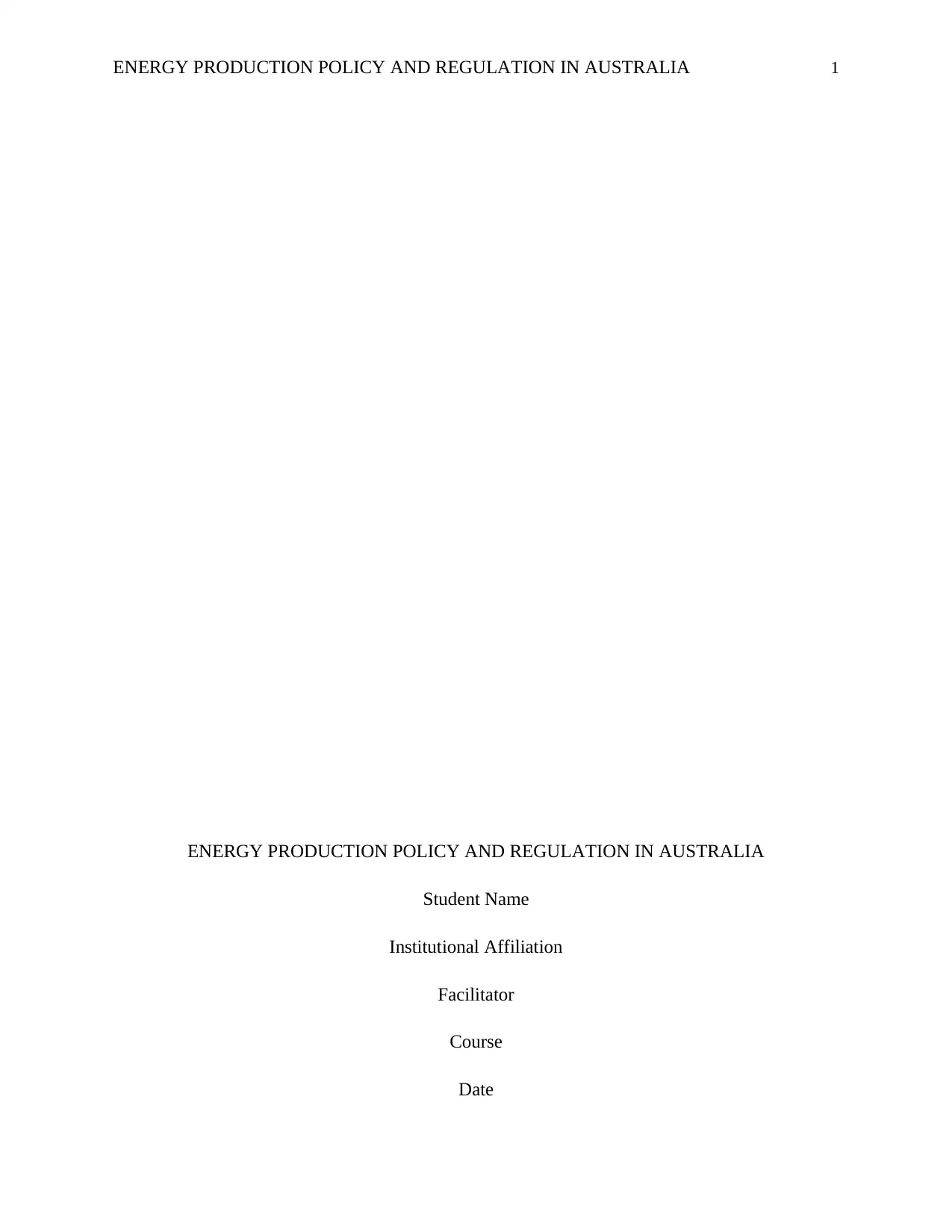
ENERGY PRODUCTION POLICY AND REGULATION IN AUSTRALIA 1
ENERGY PRODUCTION POLICY AND REGULATION IN AUSTRALIA
Student Name
Institutional Affiliation
Facilitator
Course
Date
ENERGY PRODUCTION POLICY AND REGULATION IN AUSTRALIA
Student Name
Institutional Affiliation
Facilitator
Course
Date
Paraphrase This Document
Need a fresh take? Get an instant paraphrase of this document with our AI Paraphraser
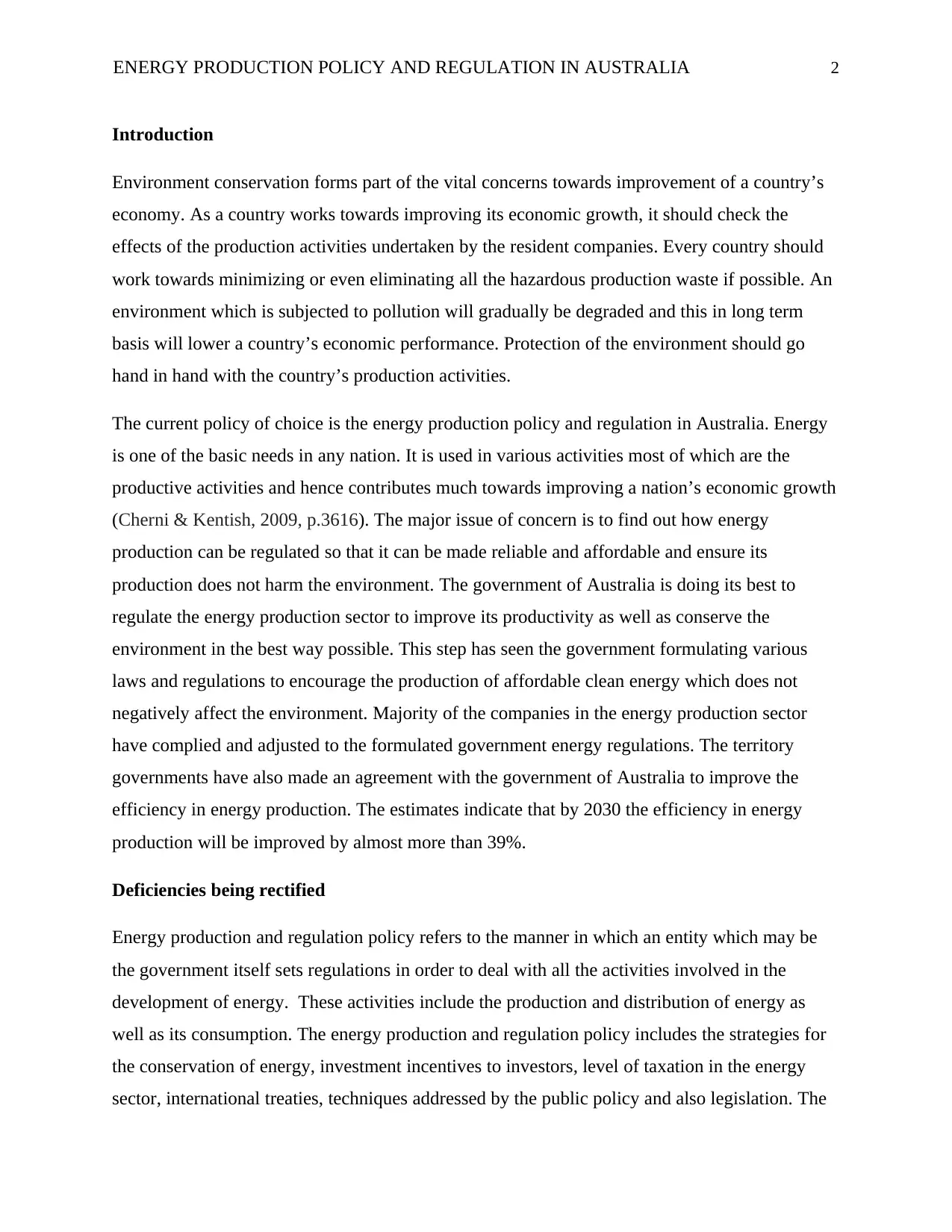
ENERGY PRODUCTION POLICY AND REGULATION IN AUSTRALIA 2
Introduction
Environment conservation forms part of the vital concerns towards improvement of a country’s
economy. As a country works towards improving its economic growth, it should check the
effects of the production activities undertaken by the resident companies. Every country should
work towards minimizing or even eliminating all the hazardous production waste if possible. An
environment which is subjected to pollution will gradually be degraded and this in long term
basis will lower a country’s economic performance. Protection of the environment should go
hand in hand with the country’s production activities.
The current policy of choice is the energy production policy and regulation in Australia. Energy
is one of the basic needs in any nation. It is used in various activities most of which are the
productive activities and hence contributes much towards improving a nation’s economic growth
(Cherni & Kentish, 2009, p.3616). The major issue of concern is to find out how energy
production can be regulated so that it can be made reliable and affordable and ensure its
production does not harm the environment. The government of Australia is doing its best to
regulate the energy production sector to improve its productivity as well as conserve the
environment in the best way possible. This step has seen the government formulating various
laws and regulations to encourage the production of affordable clean energy which does not
negatively affect the environment. Majority of the companies in the energy production sector
have complied and adjusted to the formulated government energy regulations. The territory
governments have also made an agreement with the government of Australia to improve the
efficiency in energy production. The estimates indicate that by 2030 the efficiency in energy
production will be improved by almost more than 39%.
Deficiencies being rectified
Energy production and regulation policy refers to the manner in which an entity which may be
the government itself sets regulations in order to deal with all the activities involved in the
development of energy. These activities include the production and distribution of energy as
well as its consumption. The energy production and regulation policy includes the strategies for
the conservation of energy, investment incentives to investors, level of taxation in the energy
sector, international treaties, techniques addressed by the public policy and also legislation. The
Introduction
Environment conservation forms part of the vital concerns towards improvement of a country’s
economy. As a country works towards improving its economic growth, it should check the
effects of the production activities undertaken by the resident companies. Every country should
work towards minimizing or even eliminating all the hazardous production waste if possible. An
environment which is subjected to pollution will gradually be degraded and this in long term
basis will lower a country’s economic performance. Protection of the environment should go
hand in hand with the country’s production activities.
The current policy of choice is the energy production policy and regulation in Australia. Energy
is one of the basic needs in any nation. It is used in various activities most of which are the
productive activities and hence contributes much towards improving a nation’s economic growth
(Cherni & Kentish, 2009, p.3616). The major issue of concern is to find out how energy
production can be regulated so that it can be made reliable and affordable and ensure its
production does not harm the environment. The government of Australia is doing its best to
regulate the energy production sector to improve its productivity as well as conserve the
environment in the best way possible. This step has seen the government formulating various
laws and regulations to encourage the production of affordable clean energy which does not
negatively affect the environment. Majority of the companies in the energy production sector
have complied and adjusted to the formulated government energy regulations. The territory
governments have also made an agreement with the government of Australia to improve the
efficiency in energy production. The estimates indicate that by 2030 the efficiency in energy
production will be improved by almost more than 39%.
Deficiencies being rectified
Energy production and regulation policy refers to the manner in which an entity which may be
the government itself sets regulations in order to deal with all the activities involved in the
development of energy. These activities include the production and distribution of energy as
well as its consumption. The energy production and regulation policy includes the strategies for
the conservation of energy, investment incentives to investors, level of taxation in the energy
sector, international treaties, techniques addressed by the public policy and also legislation. The
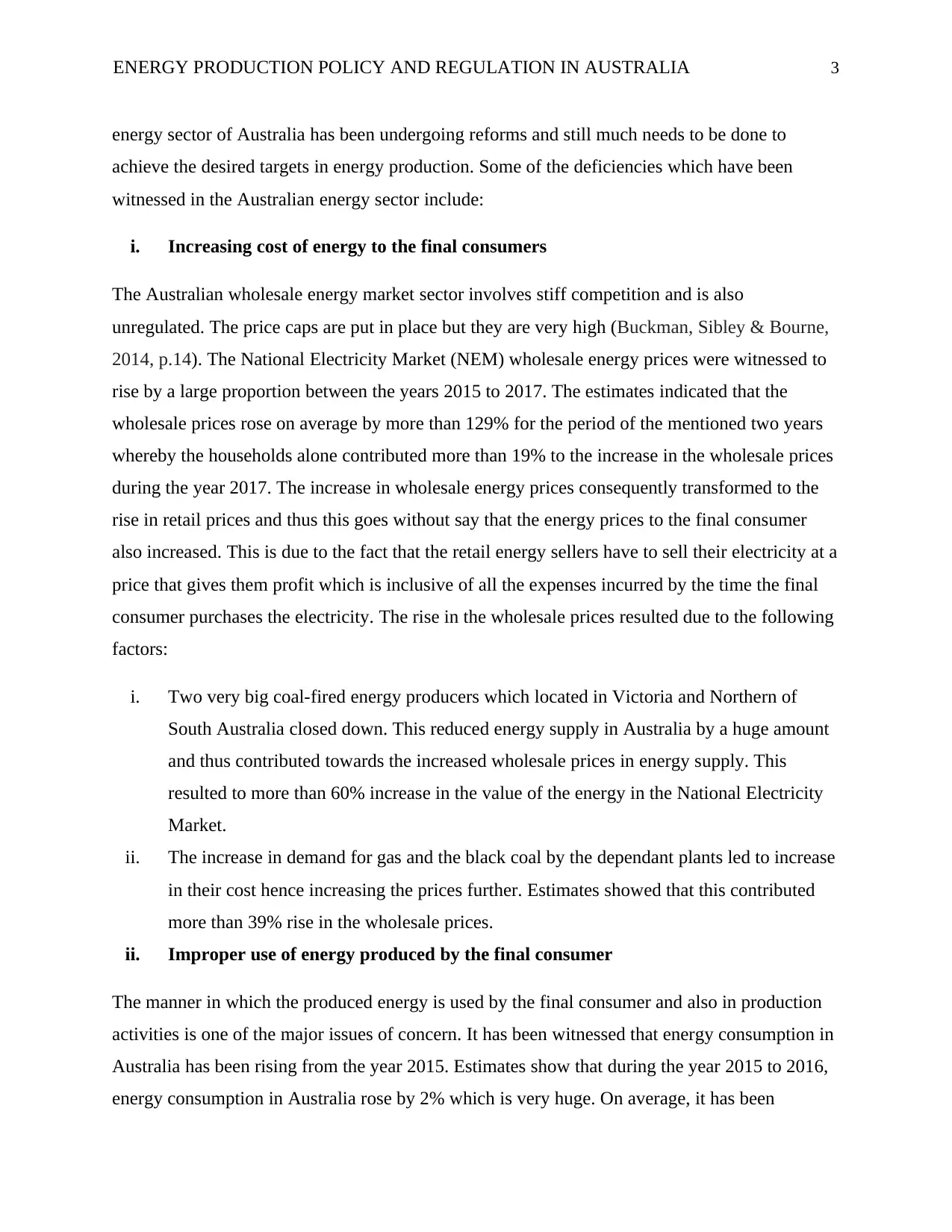
ENERGY PRODUCTION POLICY AND REGULATION IN AUSTRALIA 3
energy sector of Australia has been undergoing reforms and still much needs to be done to
achieve the desired targets in energy production. Some of the deficiencies which have been
witnessed in the Australian energy sector include:
i. Increasing cost of energy to the final consumers
The Australian wholesale energy market sector involves stiff competition and is also
unregulated. The price caps are put in place but they are very high (Buckman, Sibley & Bourne,
2014, p.14). The National Electricity Market (NEM) wholesale energy prices were witnessed to
rise by a large proportion between the years 2015 to 2017. The estimates indicated that the
wholesale prices rose on average by more than 129% for the period of the mentioned two years
whereby the households alone contributed more than 19% to the increase in the wholesale prices
during the year 2017. The increase in wholesale energy prices consequently transformed to the
rise in retail prices and thus this goes without say that the energy prices to the final consumer
also increased. This is due to the fact that the retail energy sellers have to sell their electricity at a
price that gives them profit which is inclusive of all the expenses incurred by the time the final
consumer purchases the electricity. The rise in the wholesale prices resulted due to the following
factors:
i. Two very big coal-fired energy producers which located in Victoria and Northern of
South Australia closed down. This reduced energy supply in Australia by a huge amount
and thus contributed towards the increased wholesale prices in energy supply. This
resulted to more than 60% increase in the value of the energy in the National Electricity
Market.
ii. The increase in demand for gas and the black coal by the dependant plants led to increase
in their cost hence increasing the prices further. Estimates showed that this contributed
more than 39% rise in the wholesale prices.
ii. Improper use of energy produced by the final consumer
The manner in which the produced energy is used by the final consumer and also in production
activities is one of the major issues of concern. It has been witnessed that energy consumption in
Australia has been rising from the year 2015. Estimates show that during the year 2015 to 2016,
energy consumption in Australia rose by 2% which is very huge. On average, it has been
energy sector of Australia has been undergoing reforms and still much needs to be done to
achieve the desired targets in energy production. Some of the deficiencies which have been
witnessed in the Australian energy sector include:
i. Increasing cost of energy to the final consumers
The Australian wholesale energy market sector involves stiff competition and is also
unregulated. The price caps are put in place but they are very high (Buckman, Sibley & Bourne,
2014, p.14). The National Electricity Market (NEM) wholesale energy prices were witnessed to
rise by a large proportion between the years 2015 to 2017. The estimates indicated that the
wholesale prices rose on average by more than 129% for the period of the mentioned two years
whereby the households alone contributed more than 19% to the increase in the wholesale prices
during the year 2017. The increase in wholesale energy prices consequently transformed to the
rise in retail prices and thus this goes without say that the energy prices to the final consumer
also increased. This is due to the fact that the retail energy sellers have to sell their electricity at a
price that gives them profit which is inclusive of all the expenses incurred by the time the final
consumer purchases the electricity. The rise in the wholesale prices resulted due to the following
factors:
i. Two very big coal-fired energy producers which located in Victoria and Northern of
South Australia closed down. This reduced energy supply in Australia by a huge amount
and thus contributed towards the increased wholesale prices in energy supply. This
resulted to more than 60% increase in the value of the energy in the National Electricity
Market.
ii. The increase in demand for gas and the black coal by the dependant plants led to increase
in their cost hence increasing the prices further. Estimates showed that this contributed
more than 39% rise in the wholesale prices.
ii. Improper use of energy produced by the final consumer
The manner in which the produced energy is used by the final consumer and also in production
activities is one of the major issues of concern. It has been witnessed that energy consumption in
Australia has been rising from the year 2015. Estimates show that during the year 2015 to 2016,
energy consumption in Australia rose by 2% which is very huge. On average, it has been
⊘ This is a preview!⊘
Do you want full access?
Subscribe today to unlock all pages.

Trusted by 1+ million students worldwide
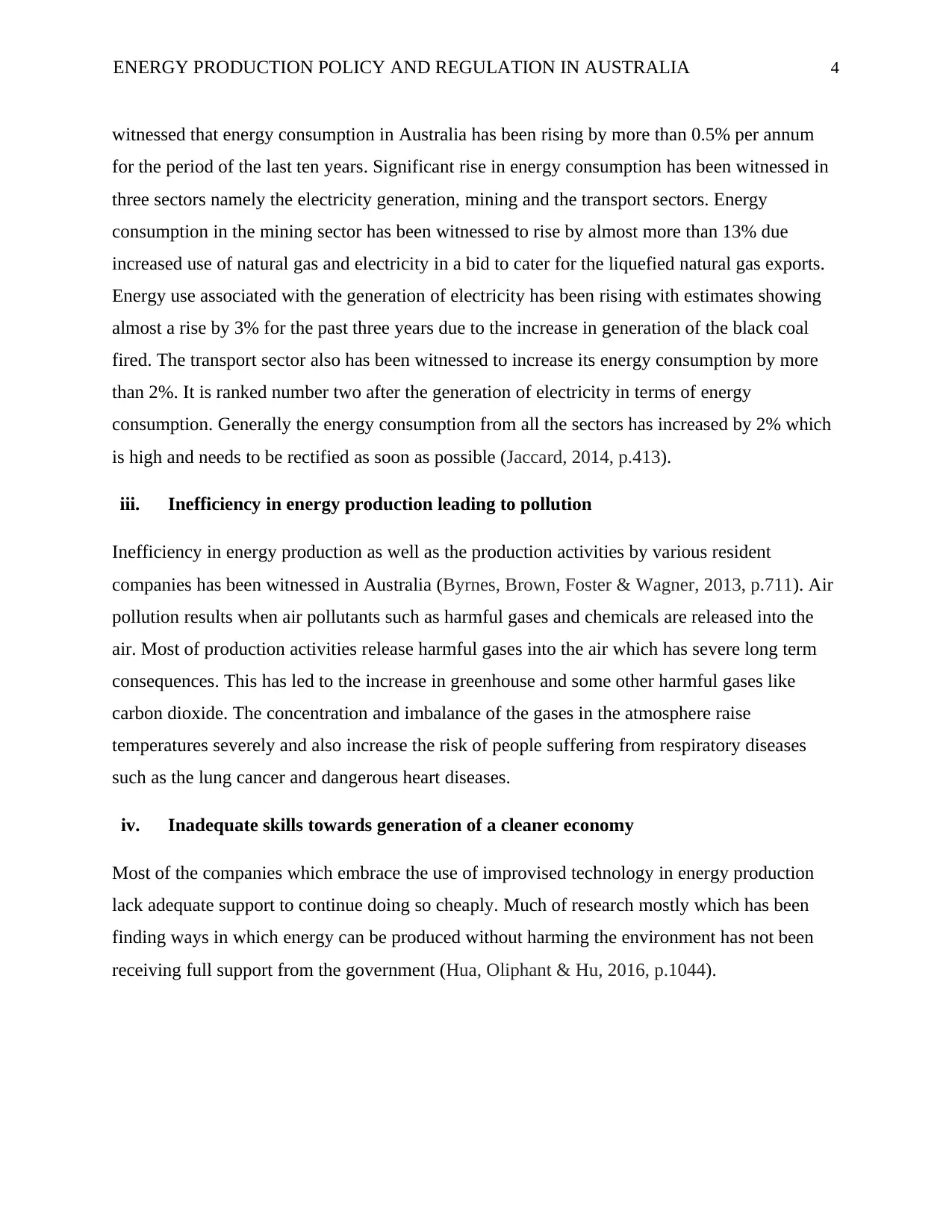
ENERGY PRODUCTION POLICY AND REGULATION IN AUSTRALIA 4
witnessed that energy consumption in Australia has been rising by more than 0.5% per annum
for the period of the last ten years. Significant rise in energy consumption has been witnessed in
three sectors namely the electricity generation, mining and the transport sectors. Energy
consumption in the mining sector has been witnessed to rise by almost more than 13% due
increased use of natural gas and electricity in a bid to cater for the liquefied natural gas exports.
Energy use associated with the generation of electricity has been rising with estimates showing
almost a rise by 3% for the past three years due to the increase in generation of the black coal
fired. The transport sector also has been witnessed to increase its energy consumption by more
than 2%. It is ranked number two after the generation of electricity in terms of energy
consumption. Generally the energy consumption from all the sectors has increased by 2% which
is high and needs to be rectified as soon as possible (Jaccard, 2014, p.413).
iii. Inefficiency in energy production leading to pollution
Inefficiency in energy production as well as the production activities by various resident
companies has been witnessed in Australia (Byrnes, Brown, Foster & Wagner, 2013, p.711). Air
pollution results when air pollutants such as harmful gases and chemicals are released into the
air. Most of production activities release harmful gases into the air which has severe long term
consequences. This has led to the increase in greenhouse and some other harmful gases like
carbon dioxide. The concentration and imbalance of the gases in the atmosphere raise
temperatures severely and also increase the risk of people suffering from respiratory diseases
such as the lung cancer and dangerous heart diseases.
iv. Inadequate skills towards generation of a cleaner economy
Most of the companies which embrace the use of improvised technology in energy production
lack adequate support to continue doing so cheaply. Much of research mostly which has been
finding ways in which energy can be produced without harming the environment has not been
receiving full support from the government (Hua, Oliphant & Hu, 2016, p.1044).
witnessed that energy consumption in Australia has been rising by more than 0.5% per annum
for the period of the last ten years. Significant rise in energy consumption has been witnessed in
three sectors namely the electricity generation, mining and the transport sectors. Energy
consumption in the mining sector has been witnessed to rise by almost more than 13% due
increased use of natural gas and electricity in a bid to cater for the liquefied natural gas exports.
Energy use associated with the generation of electricity has been rising with estimates showing
almost a rise by 3% for the past three years due to the increase in generation of the black coal
fired. The transport sector also has been witnessed to increase its energy consumption by more
than 2%. It is ranked number two after the generation of electricity in terms of energy
consumption. Generally the energy consumption from all the sectors has increased by 2% which
is high and needs to be rectified as soon as possible (Jaccard, 2014, p.413).
iii. Inefficiency in energy production leading to pollution
Inefficiency in energy production as well as the production activities by various resident
companies has been witnessed in Australia (Byrnes, Brown, Foster & Wagner, 2013, p.711). Air
pollution results when air pollutants such as harmful gases and chemicals are released into the
air. Most of production activities release harmful gases into the air which has severe long term
consequences. This has led to the increase in greenhouse and some other harmful gases like
carbon dioxide. The concentration and imbalance of the gases in the atmosphere raise
temperatures severely and also increase the risk of people suffering from respiratory diseases
such as the lung cancer and dangerous heart diseases.
iv. Inadequate skills towards generation of a cleaner economy
Most of the companies which embrace the use of improvised technology in energy production
lack adequate support to continue doing so cheaply. Much of research mostly which has been
finding ways in which energy can be produced without harming the environment has not been
receiving full support from the government (Hua, Oliphant & Hu, 2016, p.1044).
Paraphrase This Document
Need a fresh take? Get an instant paraphrase of this document with our AI Paraphraser
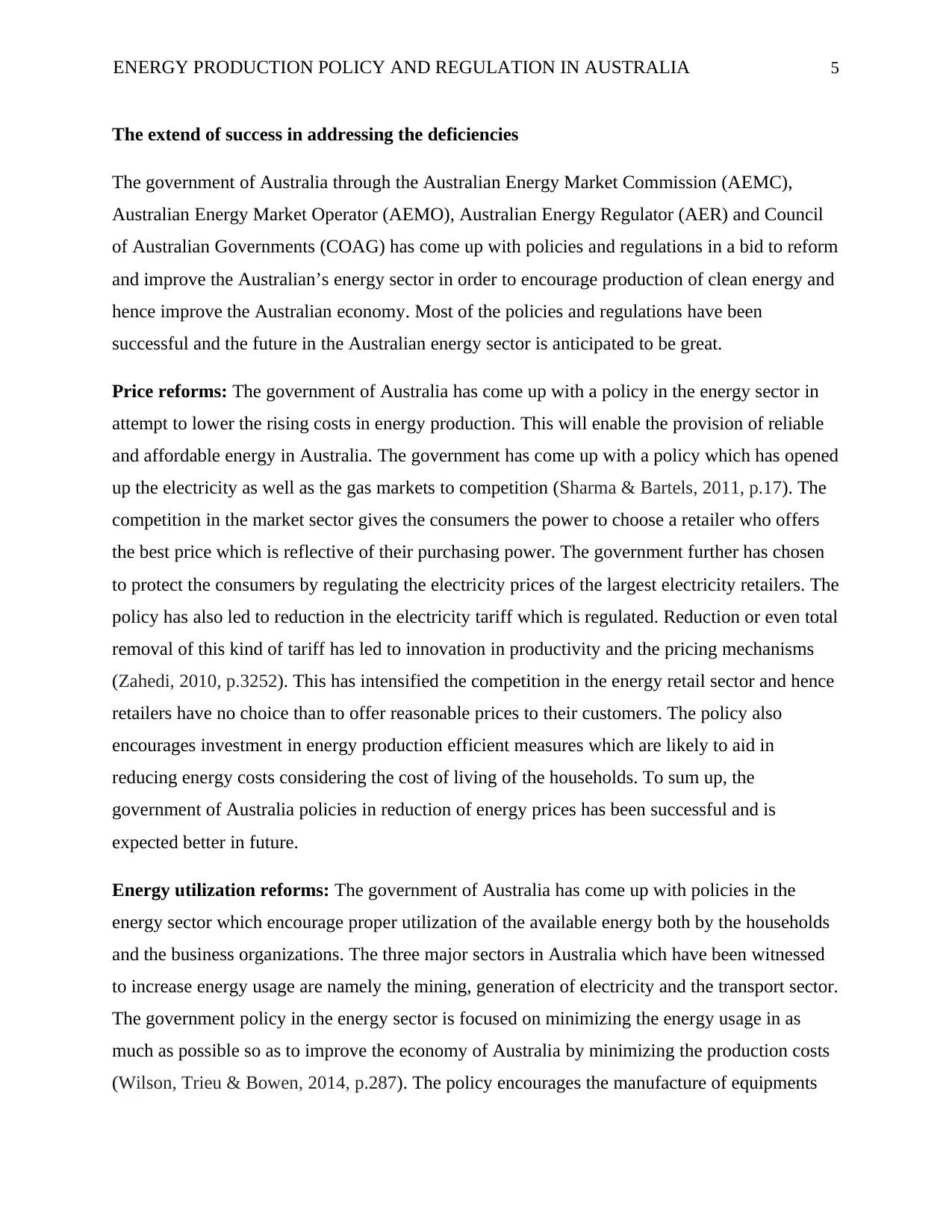
ENERGY PRODUCTION POLICY AND REGULATION IN AUSTRALIA 5
The extend of success in addressing the deficiencies
The government of Australia through the Australian Energy Market Commission (AEMC),
Australian Energy Market Operator (AEMO), Australian Energy Regulator (AER) and Council
of Australian Governments (COAG) has come up with policies and regulations in a bid to reform
and improve the Australian’s energy sector in order to encourage production of clean energy and
hence improve the Australian economy. Most of the policies and regulations have been
successful and the future in the Australian energy sector is anticipated to be great.
Price reforms: The government of Australia has come up with a policy in the energy sector in
attempt to lower the rising costs in energy production. This will enable the provision of reliable
and affordable energy in Australia. The government has come up with a policy which has opened
up the electricity as well as the gas markets to competition (Sharma & Bartels, 2011, p.17). The
competition in the market sector gives the consumers the power to choose a retailer who offers
the best price which is reflective of their purchasing power. The government further has chosen
to protect the consumers by regulating the electricity prices of the largest electricity retailers. The
policy has also led to reduction in the electricity tariff which is regulated. Reduction or even total
removal of this kind of tariff has led to innovation in productivity and the pricing mechanisms
(Zahedi, 2010, p.3252). This has intensified the competition in the energy retail sector and hence
retailers have no choice than to offer reasonable prices to their customers. The policy also
encourages investment in energy production efficient measures which are likely to aid in
reducing energy costs considering the cost of living of the households. To sum up, the
government of Australia policies in reduction of energy prices has been successful and is
expected better in future.
Energy utilization reforms: The government of Australia has come up with policies in the
energy sector which encourage proper utilization of the available energy both by the households
and the business organizations. The three major sectors in Australia which have been witnessed
to increase energy usage are namely the mining, generation of electricity and the transport sector.
The government policy in the energy sector is focused on minimizing the energy usage in as
much as possible so as to improve the economy of Australia by minimizing the production costs
(Wilson, Trieu & Bowen, 2014, p.287). The policy encourages the manufacture of equipments
The extend of success in addressing the deficiencies
The government of Australia through the Australian Energy Market Commission (AEMC),
Australian Energy Market Operator (AEMO), Australian Energy Regulator (AER) and Council
of Australian Governments (COAG) has come up with policies and regulations in a bid to reform
and improve the Australian’s energy sector in order to encourage production of clean energy and
hence improve the Australian economy. Most of the policies and regulations have been
successful and the future in the Australian energy sector is anticipated to be great.
Price reforms: The government of Australia has come up with a policy in the energy sector in
attempt to lower the rising costs in energy production. This will enable the provision of reliable
and affordable energy in Australia. The government has come up with a policy which has opened
up the electricity as well as the gas markets to competition (Sharma & Bartels, 2011, p.17). The
competition in the market sector gives the consumers the power to choose a retailer who offers
the best price which is reflective of their purchasing power. The government further has chosen
to protect the consumers by regulating the electricity prices of the largest electricity retailers. The
policy has also led to reduction in the electricity tariff which is regulated. Reduction or even total
removal of this kind of tariff has led to innovation in productivity and the pricing mechanisms
(Zahedi, 2010, p.3252). This has intensified the competition in the energy retail sector and hence
retailers have no choice than to offer reasonable prices to their customers. The policy also
encourages investment in energy production efficient measures which are likely to aid in
reducing energy costs considering the cost of living of the households. To sum up, the
government of Australia policies in reduction of energy prices has been successful and is
expected better in future.
Energy utilization reforms: The government of Australia has come up with policies in the
energy sector which encourage proper utilization of the available energy both by the households
and the business organizations. The three major sectors in Australia which have been witnessed
to increase energy usage are namely the mining, generation of electricity and the transport sector.
The government policy in the energy sector is focused on minimizing the energy usage in as
much as possible so as to improve the economy of Australia by minimizing the production costs
(Wilson, Trieu & Bowen, 2014, p.287). The policy encourages the manufacture of equipments
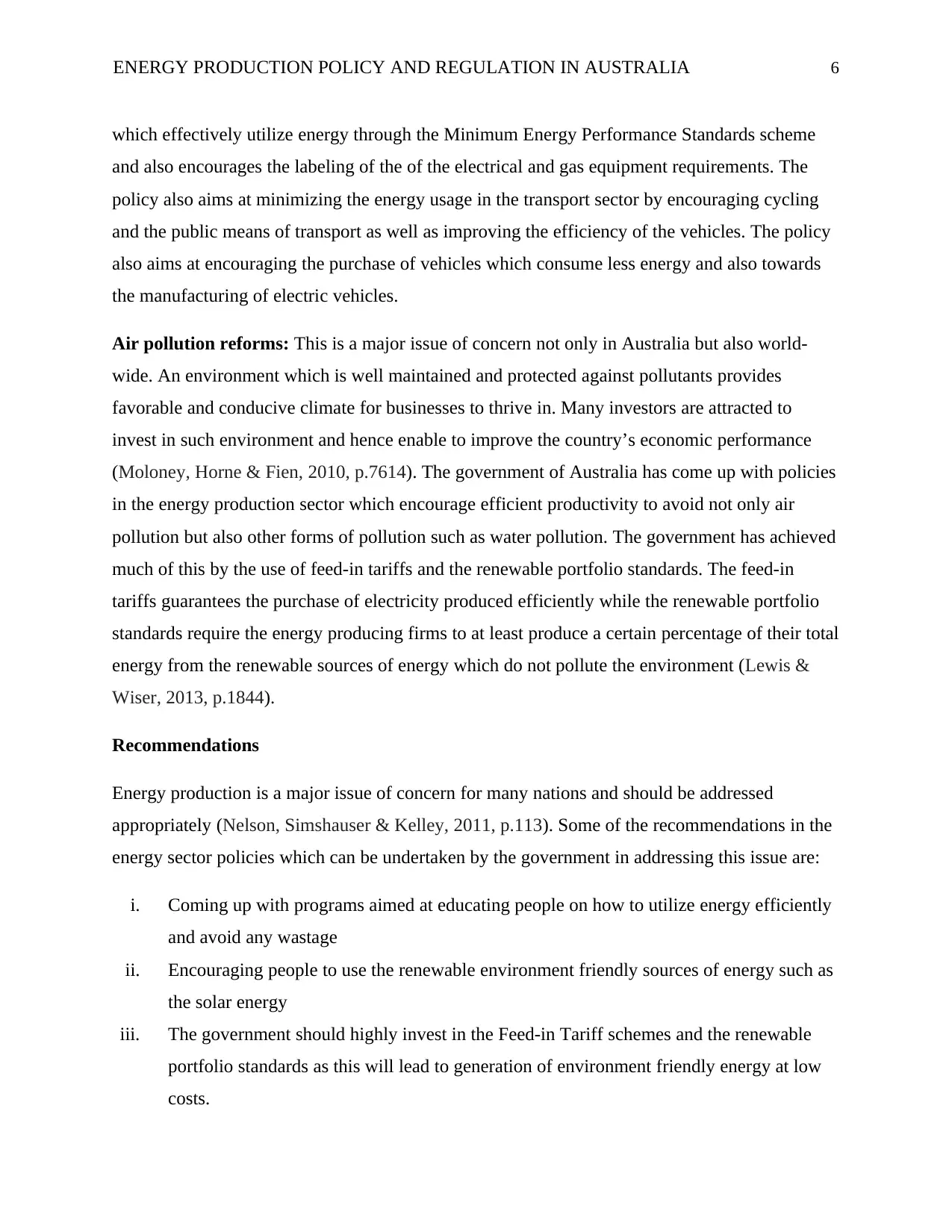
ENERGY PRODUCTION POLICY AND REGULATION IN AUSTRALIA 6
which effectively utilize energy through the Minimum Energy Performance Standards scheme
and also encourages the labeling of the of the electrical and gas equipment requirements. The
policy also aims at minimizing the energy usage in the transport sector by encouraging cycling
and the public means of transport as well as improving the efficiency of the vehicles. The policy
also aims at encouraging the purchase of vehicles which consume less energy and also towards
the manufacturing of electric vehicles.
Air pollution reforms: This is a major issue of concern not only in Australia but also world-
wide. An environment which is well maintained and protected against pollutants provides
favorable and conducive climate for businesses to thrive in. Many investors are attracted to
invest in such environment and hence enable to improve the country’s economic performance
(Moloney, Horne & Fien, 2010, p.7614). The government of Australia has come up with policies
in the energy production sector which encourage efficient productivity to avoid not only air
pollution but also other forms of pollution such as water pollution. The government has achieved
much of this by the use of feed-in tariffs and the renewable portfolio standards. The feed-in
tariffs guarantees the purchase of electricity produced efficiently while the renewable portfolio
standards require the energy producing firms to at least produce a certain percentage of their total
energy from the renewable sources of energy which do not pollute the environment (Lewis &
Wiser, 2013, p.1844).
Recommendations
Energy production is a major issue of concern for many nations and should be addressed
appropriately (Nelson, Simshauser & Kelley, 2011, p.113). Some of the recommendations in the
energy sector policies which can be undertaken by the government in addressing this issue are:
i. Coming up with programs aimed at educating people on how to utilize energy efficiently
and avoid any wastage
ii. Encouraging people to use the renewable environment friendly sources of energy such as
the solar energy
iii. The government should highly invest in the Feed-in Tariff schemes and the renewable
portfolio standards as this will lead to generation of environment friendly energy at low
costs.
which effectively utilize energy through the Minimum Energy Performance Standards scheme
and also encourages the labeling of the of the electrical and gas equipment requirements. The
policy also aims at minimizing the energy usage in the transport sector by encouraging cycling
and the public means of transport as well as improving the efficiency of the vehicles. The policy
also aims at encouraging the purchase of vehicles which consume less energy and also towards
the manufacturing of electric vehicles.
Air pollution reforms: This is a major issue of concern not only in Australia but also world-
wide. An environment which is well maintained and protected against pollutants provides
favorable and conducive climate for businesses to thrive in. Many investors are attracted to
invest in such environment and hence enable to improve the country’s economic performance
(Moloney, Horne & Fien, 2010, p.7614). The government of Australia has come up with policies
in the energy production sector which encourage efficient productivity to avoid not only air
pollution but also other forms of pollution such as water pollution. The government has achieved
much of this by the use of feed-in tariffs and the renewable portfolio standards. The feed-in
tariffs guarantees the purchase of electricity produced efficiently while the renewable portfolio
standards require the energy producing firms to at least produce a certain percentage of their total
energy from the renewable sources of energy which do not pollute the environment (Lewis &
Wiser, 2013, p.1844).
Recommendations
Energy production is a major issue of concern for many nations and should be addressed
appropriately (Nelson, Simshauser & Kelley, 2011, p.113). Some of the recommendations in the
energy sector policies which can be undertaken by the government in addressing this issue are:
i. Coming up with programs aimed at educating people on how to utilize energy efficiently
and avoid any wastage
ii. Encouraging people to use the renewable environment friendly sources of energy such as
the solar energy
iii. The government should highly invest in the Feed-in Tariff schemes and the renewable
portfolio standards as this will lead to generation of environment friendly energy at low
costs.
⊘ This is a preview!⊘
Do you want full access?
Subscribe today to unlock all pages.

Trusted by 1+ million students worldwide
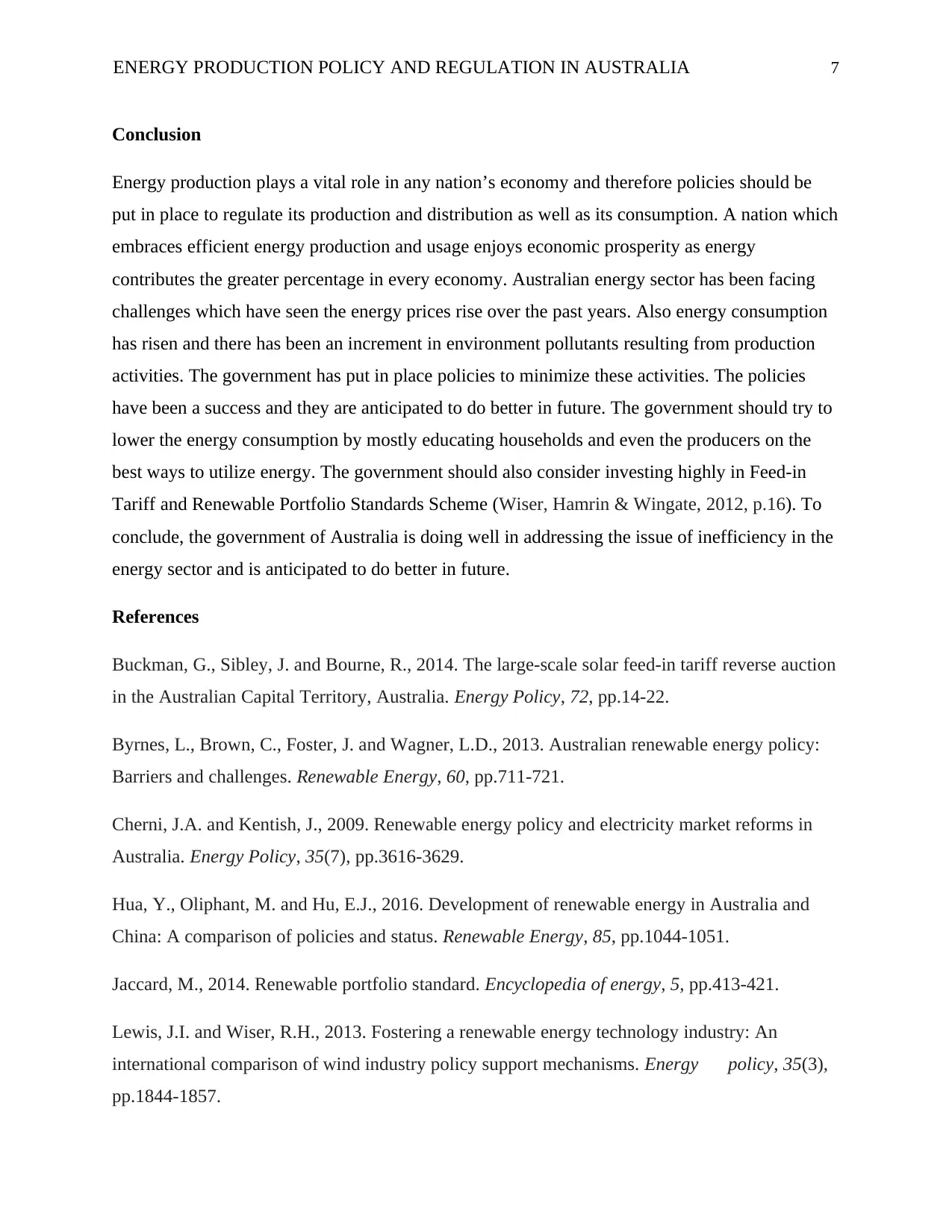
ENERGY PRODUCTION POLICY AND REGULATION IN AUSTRALIA 7
Conclusion
Energy production plays a vital role in any nation’s economy and therefore policies should be
put in place to regulate its production and distribution as well as its consumption. A nation which
embraces efficient energy production and usage enjoys economic prosperity as energy
contributes the greater percentage in every economy. Australian energy sector has been facing
challenges which have seen the energy prices rise over the past years. Also energy consumption
has risen and there has been an increment in environment pollutants resulting from production
activities. The government has put in place policies to minimize these activities. The policies
have been a success and they are anticipated to do better in future. The government should try to
lower the energy consumption by mostly educating households and even the producers on the
best ways to utilize energy. The government should also consider investing highly in Feed-in
Tariff and Renewable Portfolio Standards Scheme (Wiser, Hamrin & Wingate, 2012, p.16). To
conclude, the government of Australia is doing well in addressing the issue of inefficiency in the
energy sector and is anticipated to do better in future.
References
Buckman, G., Sibley, J. and Bourne, R., 2014. The large-scale solar feed-in tariff reverse auction
in the Australian Capital Territory, Australia. Energy Policy, 72, pp.14-22.
Byrnes, L., Brown, C., Foster, J. and Wagner, L.D., 2013. Australian renewable energy policy:
Barriers and challenges. Renewable Energy, 60, pp.711-721.
Cherni, J.A. and Kentish, J., 2009. Renewable energy policy and electricity market reforms in
Australia. Energy Policy, 35(7), pp.3616-3629.
Hua, Y., Oliphant, M. and Hu, E.J., 2016. Development of renewable energy in Australia and
China: A comparison of policies and status. Renewable Energy, 85, pp.1044-1051.
Jaccard, M., 2014. Renewable portfolio standard. Encyclopedia of energy, 5, pp.413-421.
Lewis, J.I. and Wiser, R.H., 2013. Fostering a renewable energy technology industry: An
international comparison of wind industry policy support mechanisms. Energy policy, 35(3),
pp.1844-1857.
Conclusion
Energy production plays a vital role in any nation’s economy and therefore policies should be
put in place to regulate its production and distribution as well as its consumption. A nation which
embraces efficient energy production and usage enjoys economic prosperity as energy
contributes the greater percentage in every economy. Australian energy sector has been facing
challenges which have seen the energy prices rise over the past years. Also energy consumption
has risen and there has been an increment in environment pollutants resulting from production
activities. The government has put in place policies to minimize these activities. The policies
have been a success and they are anticipated to do better in future. The government should try to
lower the energy consumption by mostly educating households and even the producers on the
best ways to utilize energy. The government should also consider investing highly in Feed-in
Tariff and Renewable Portfolio Standards Scheme (Wiser, Hamrin & Wingate, 2012, p.16). To
conclude, the government of Australia is doing well in addressing the issue of inefficiency in the
energy sector and is anticipated to do better in future.
References
Buckman, G., Sibley, J. and Bourne, R., 2014. The large-scale solar feed-in tariff reverse auction
in the Australian Capital Territory, Australia. Energy Policy, 72, pp.14-22.
Byrnes, L., Brown, C., Foster, J. and Wagner, L.D., 2013. Australian renewable energy policy:
Barriers and challenges. Renewable Energy, 60, pp.711-721.
Cherni, J.A. and Kentish, J., 2009. Renewable energy policy and electricity market reforms in
Australia. Energy Policy, 35(7), pp.3616-3629.
Hua, Y., Oliphant, M. and Hu, E.J., 2016. Development of renewable energy in Australia and
China: A comparison of policies and status. Renewable Energy, 85, pp.1044-1051.
Jaccard, M., 2014. Renewable portfolio standard. Encyclopedia of energy, 5, pp.413-421.
Lewis, J.I. and Wiser, R.H., 2013. Fostering a renewable energy technology industry: An
international comparison of wind industry policy support mechanisms. Energy policy, 35(3),
pp.1844-1857.
Paraphrase This Document
Need a fresh take? Get an instant paraphrase of this document with our AI Paraphraser
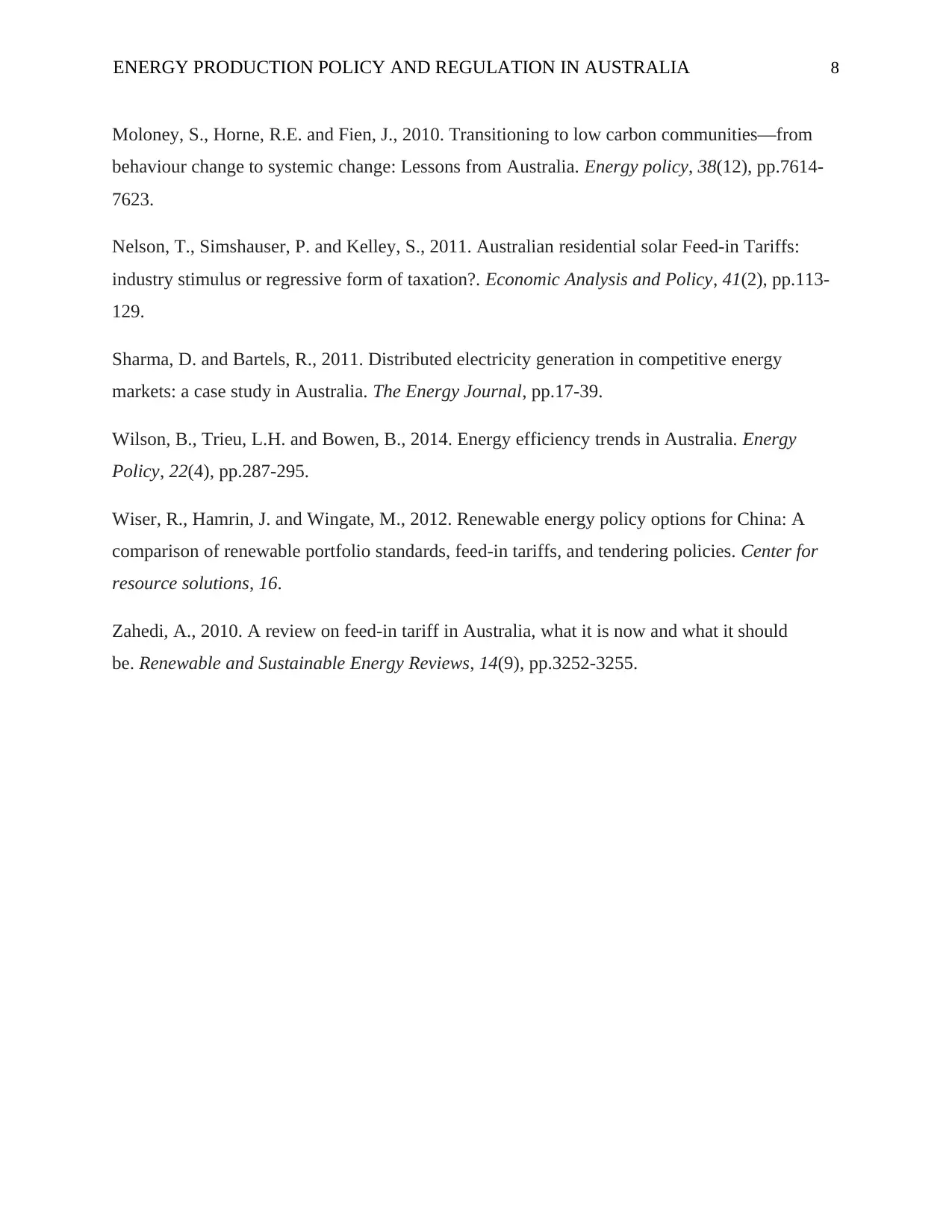
ENERGY PRODUCTION POLICY AND REGULATION IN AUSTRALIA 8
Moloney, S., Horne, R.E. and Fien, J., 2010. Transitioning to low carbon communities—from
behaviour change to systemic change: Lessons from Australia. Energy policy, 38(12), pp.7614-
7623.
Nelson, T., Simshauser, P. and Kelley, S., 2011. Australian residential solar Feed-in Tariffs:
industry stimulus or regressive form of taxation?. Economic Analysis and Policy, 41(2), pp.113-
129.
Sharma, D. and Bartels, R., 2011. Distributed electricity generation in competitive energy
markets: a case study in Australia. The Energy Journal, pp.17-39.
Wilson, B., Trieu, L.H. and Bowen, B., 2014. Energy efficiency trends in Australia. Energy
Policy, 22(4), pp.287-295.
Wiser, R., Hamrin, J. and Wingate, M., 2012. Renewable energy policy options for China: A
comparison of renewable portfolio standards, feed-in tariffs, and tendering policies. Center for
resource solutions, 16.
Zahedi, A., 2010. A review on feed-in tariff in Australia, what it is now and what it should
be. Renewable and Sustainable Energy Reviews, 14(9), pp.3252-3255.
Moloney, S., Horne, R.E. and Fien, J., 2010. Transitioning to low carbon communities—from
behaviour change to systemic change: Lessons from Australia. Energy policy, 38(12), pp.7614-
7623.
Nelson, T., Simshauser, P. and Kelley, S., 2011. Australian residential solar Feed-in Tariffs:
industry stimulus or regressive form of taxation?. Economic Analysis and Policy, 41(2), pp.113-
129.
Sharma, D. and Bartels, R., 2011. Distributed electricity generation in competitive energy
markets: a case study in Australia. The Energy Journal, pp.17-39.
Wilson, B., Trieu, L.H. and Bowen, B., 2014. Energy efficiency trends in Australia. Energy
Policy, 22(4), pp.287-295.
Wiser, R., Hamrin, J. and Wingate, M., 2012. Renewable energy policy options for China: A
comparison of renewable portfolio standards, feed-in tariffs, and tendering policies. Center for
resource solutions, 16.
Zahedi, A., 2010. A review on feed-in tariff in Australia, what it is now and what it should
be. Renewable and Sustainable Energy Reviews, 14(9), pp.3252-3255.
1 out of 8
Related Documents
Your All-in-One AI-Powered Toolkit for Academic Success.
+13062052269
info@desklib.com
Available 24*7 on WhatsApp / Email
![[object Object]](/_next/static/media/star-bottom.7253800d.svg)
Unlock your academic potential
Copyright © 2020–2025 A2Z Services. All Rights Reserved. Developed and managed by ZUCOL.





